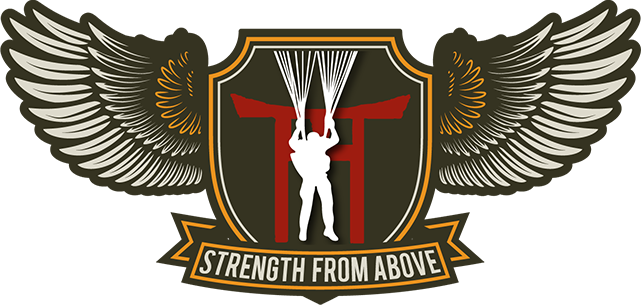The 511th PIR Blog
Down From Heaven: a History of the 11th Airborne Division in World War II Volumes 1 & 2
 11th Airborne Division historian Jeremy C. Holm is pleased to announce the second volume in his much-anticipated series on the history of the 11th Airborne Division in World War II and beyond!
11th Airborne Division historian Jeremy C. Holm is pleased to announce the second volume in his much-anticipated series on the history of the 11th Airborne Division in World War II and beyond!
The grandson of an original Angel, 1LT Andrew Carrico III of Company D, 511th Parachute Infantry Regiment, 11th Airborne Division, Jeremy is an expert on all things 11th Airborne related and has spent more than ten years studying to division's history and interviewing the last living veterans of this mighty combat unit from World War II.
NOW AVAILABLE
1. DOWN FROM HEAVEN: THE HISTORY OF THE 11TH AIRBORNE DIVISION IN WORLD WAR II - VOLUME 1: CAMP TOCCOA TO LEYTE CAMPAIGN dives into the history of the original 11th Airborne Division and the officers and men who helped form this esteemed unit which set a "record unmatched in the history of the airborne."
In DOWN FROM HEAVEN you'll read exciting first-hand accounts of the division's experiences during their stateside training periods as well as their bloody campaign to retake Leyte island from Imperial Japan. This book will bring feelings of deep respect and admiration for the young Angels who came "Down from Heaven" on parachutes and in gliders in the service of their country in World War II.
2. DOWN FROM HEAVEN: THE HISTORY OF THE 11TH AIRBORNE DIVISION IN WORLD WAR II - VOLUME 2: LUZON CAMPAIGN AND OCCUPATION OF JAPAN dives into the 11th Airborne Division's bloody campaigns to retake the island of Luzon, including the battle for Manilla, their famous raid on the Los Banos Internment Camp and the final airborne operation of the war Task Force Gypsy at Aparri.
Volume II will next cover the 11th Airborne's historic activities surrounding the surrender of Japan including how the Angels were the first Allied unit to land on Japan before they formed General Douglas MacArthur's Honor Guard, protected Allied dignitaries for the Surrender Ceremony and even delivered the Instruments of Surrender to President Truman himself. After the surrender, the 11th Airborne Division remained in Japan as "Angels of Democracy" to help their former enemies rebuild and their efforts and examples have been recognized as a guiding influence that helped Japan become the powerful country that we know today.
Click Here to Order Signed Copies
The Aparri Landings: Gypsy Task Force 76 Years Later
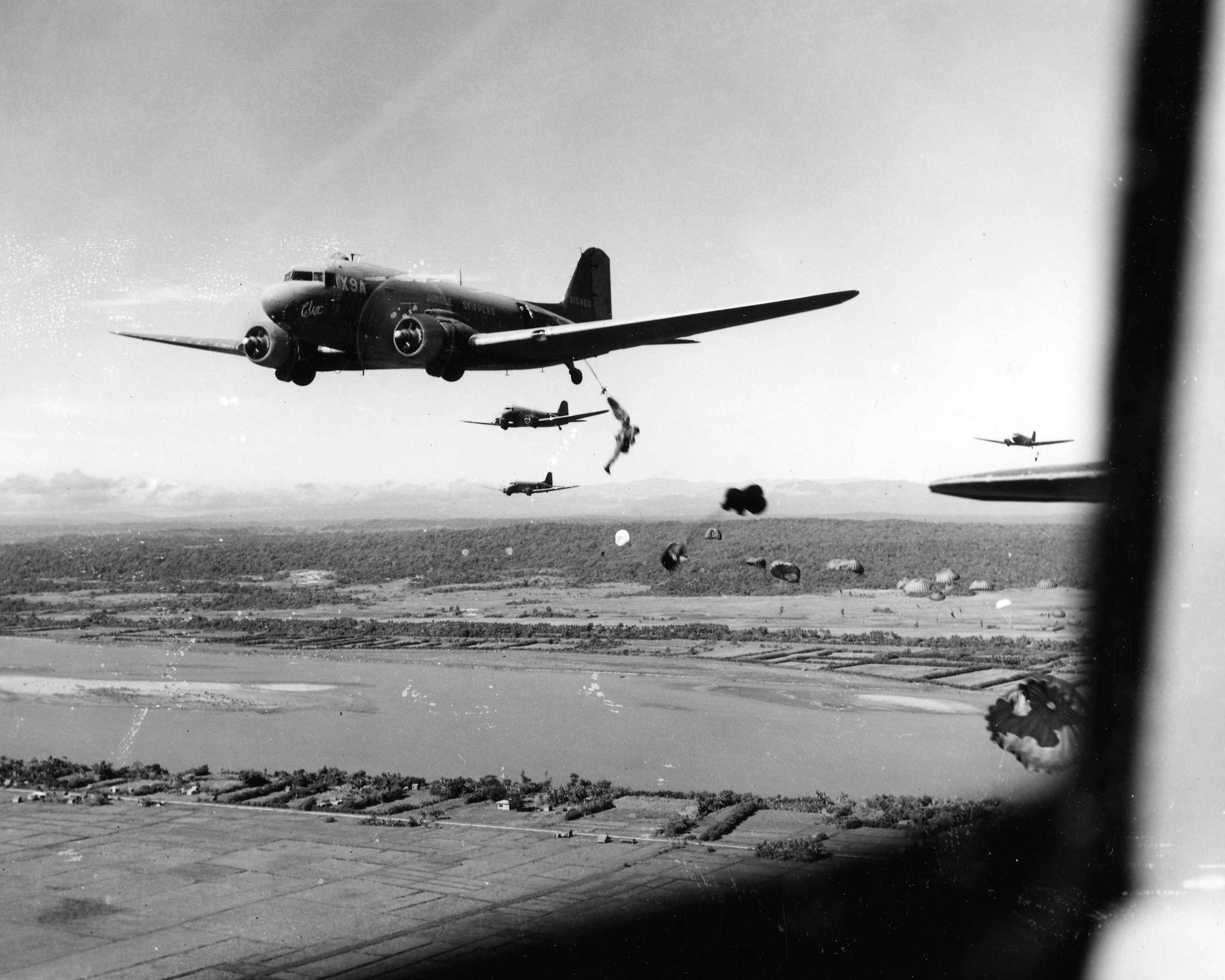 For years now I have been reading and listening to articles and podcasts mistakenly claiming that Operation Varsity (part of Operation Plunder) was the last airborne operation of World War II. While Varsity was indeed an enormous campaign that involved over 16,000 paratroopers and thousands of aircraft, it was not THE last airborne operation of the war, though in can correctly be called the last one held on such a massive scale (Varsity was the largest single-day/single-location airborne deployment in history).
For years now I have been reading and listening to articles and podcasts mistakenly claiming that Operation Varsity (part of Operation Plunder) was the last airborne operation of World War II. While Varsity was indeed an enormous campaign that involved over 16,000 paratroopers and thousands of aircraft, it was not THE last airborne operation of the war, though in can correctly be called the last one held on such a massive scale (Varsity was the largest single-day/single-location airborne deployment in history).
So, if that is the case, what WAS the last airborne operation of World War II? Answer: The 11th Airborne Division's Gypsy Task Force.
Operation Varsity kicked off March 24, 1945 in Wesel, Germany whereas the Angels' landings at Aparri, Luzon, P.I. occurred on June 23, 1945, almost three months to the day after Varsity. For decades, members of the 11th Airborne Division have heard erroneous reports stating that their brothers in the 17th Airborne Division were honored with "making the final jump of the war", but that credit actually belongs to the Angels. In addition, the 11th Airborne was scheduled to drop on Japan during the anticipated Operation Olympic in late 1945, a campaign that was thankfully aborted due to Japan's surrender. This cancelled drop would have put the Angels' last airborne deployment even later than Varsity, likely around November of 1945. But let's dig in to the actual LAST airborne deployment of the war, the Gypsy Task Force.
Origins of The Gypsy Task Force
While Nazi Germany officially surrendered to the Allies on May 7, 1945, the 11th Airborne Division was still busy fighting an indignant Imperial Japan in the Philippines. Yes, there were some in Japan's governing bodies who were leaning towards surrender as victory was becomming an increasingly hopeless prospect, Imperial forces were still fighting bloody battles across the Pacific. It is so easy to forget that while countries around the world were celebrating VE Day on May 8, 1945, Allied forces fighting in the Pacific Theater were still fighting or getting ready to launch the bloody campaigns to retake Iwo Jima, Okinawa, Luzon and Mindano. While shouts of "Peace! Peace! Its over!" rang throughout the streets of Europe, the Pacific war went on and continued to cost the Allies over one-hundred-thousand casualties.
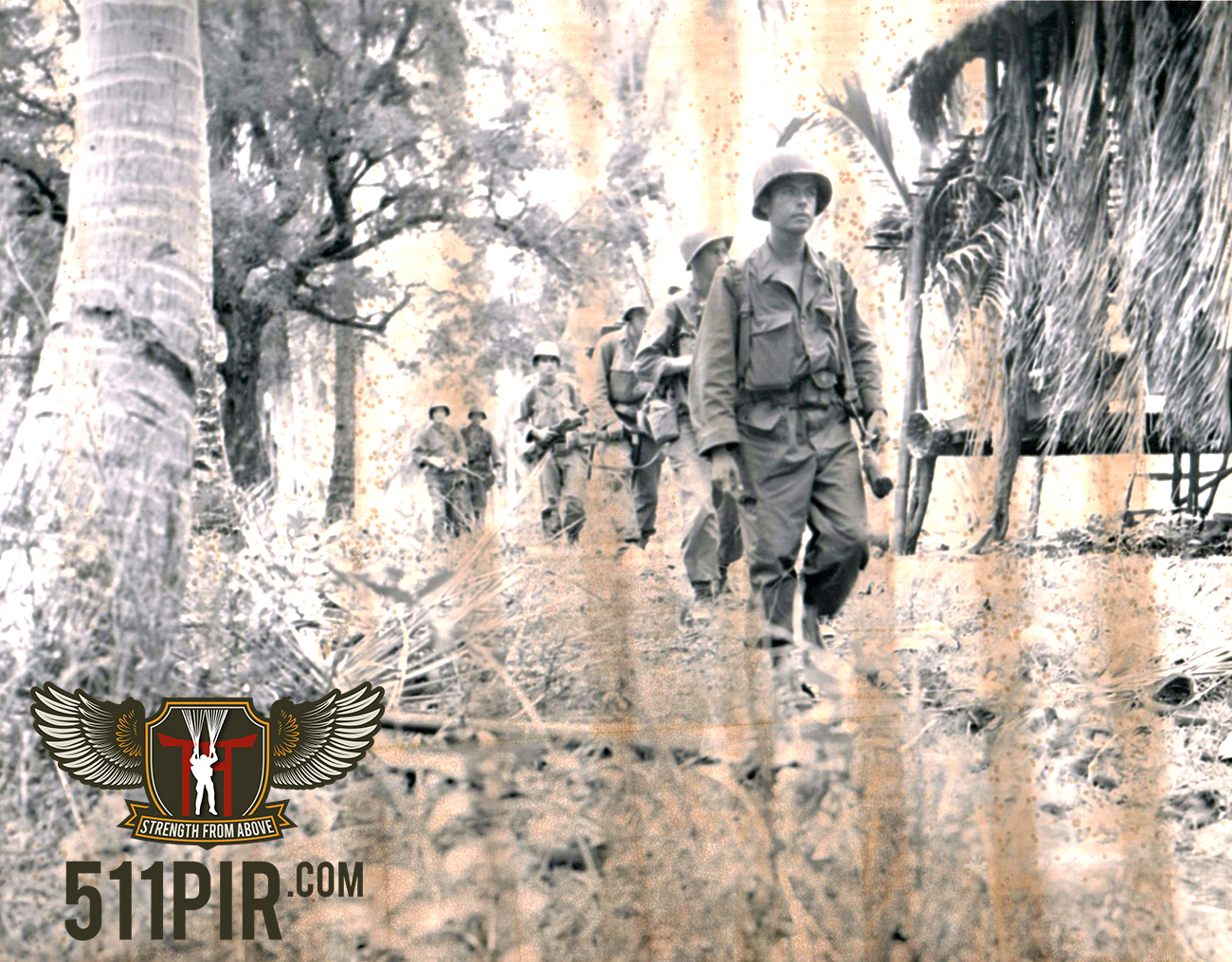 In May of 1945, AFTER VE Day, the veteran 11th Airborne Division was still heavily involved in the battle to liberate the island of Luzon in the Philippine Archipelago. Under the command of Major General Joseph May Swing, the Angels had fought their way from Nasugbu on the island's west coast, up towards Tagaytay Ridge where the division's 511th Parachute Infantry Regiment made a parachute drop on February 3, then the division pushed north to participate in the brutal Battle for Manila. For a complete description of this campaign, please consider purchasing a copy of our book on the 11th Airborne, WHEN ANGELS FALL: FROM TOCCOA TO TOKYO, THE 511TH PARACHUTE INFANTRY REGIMENT IN WORLD WAR II. The Angels suffered heavy casualties in the fight to retake the city and then in their ensuing operations to retake the mountains and cities of Luzon's southern and southeastern sectors.
In May of 1945, AFTER VE Day, the veteran 11th Airborne Division was still heavily involved in the battle to liberate the island of Luzon in the Philippine Archipelago. Under the command of Major General Joseph May Swing, the Angels had fought their way from Nasugbu on the island's west coast, up towards Tagaytay Ridge where the division's 511th Parachute Infantry Regiment made a parachute drop on February 3, then the division pushed north to participate in the brutal Battle for Manila. For a complete description of this campaign, please consider purchasing a copy of our book on the 11th Airborne, WHEN ANGELS FALL: FROM TOCCOA TO TOKYO, THE 511TH PARACHUTE INFANTRY REGIMENT IN WORLD WAR II. The Angels suffered heavy casualties in the fight to retake the city and then in their ensuing operations to retake the mountains and cities of Luzon's southern and southeastern sectors.
Things slowed down a little for a few weeks in early June when the Angels were given some time to rest and recuperate, plus integrate badly needed replacements. The division as a whole suffered 18% casualties, higher than most infantry divisions in the PTO; some of General Swing's companies had endured 70% casualties. Their short rest, however, would not last. The Japanese were still waiting in defensive pockets spread throughout Luzon. One of those pockets was centralized in northern Luzon and there was some concern was that the remnants of Japan's 150,000-man "Shobu Group", what was left of General Tomoyuki Yamashita's 14th Army, would make its way north towards the coast where perhaps the Imperial Navy could effect some sort of Dunkirk-like rescue.
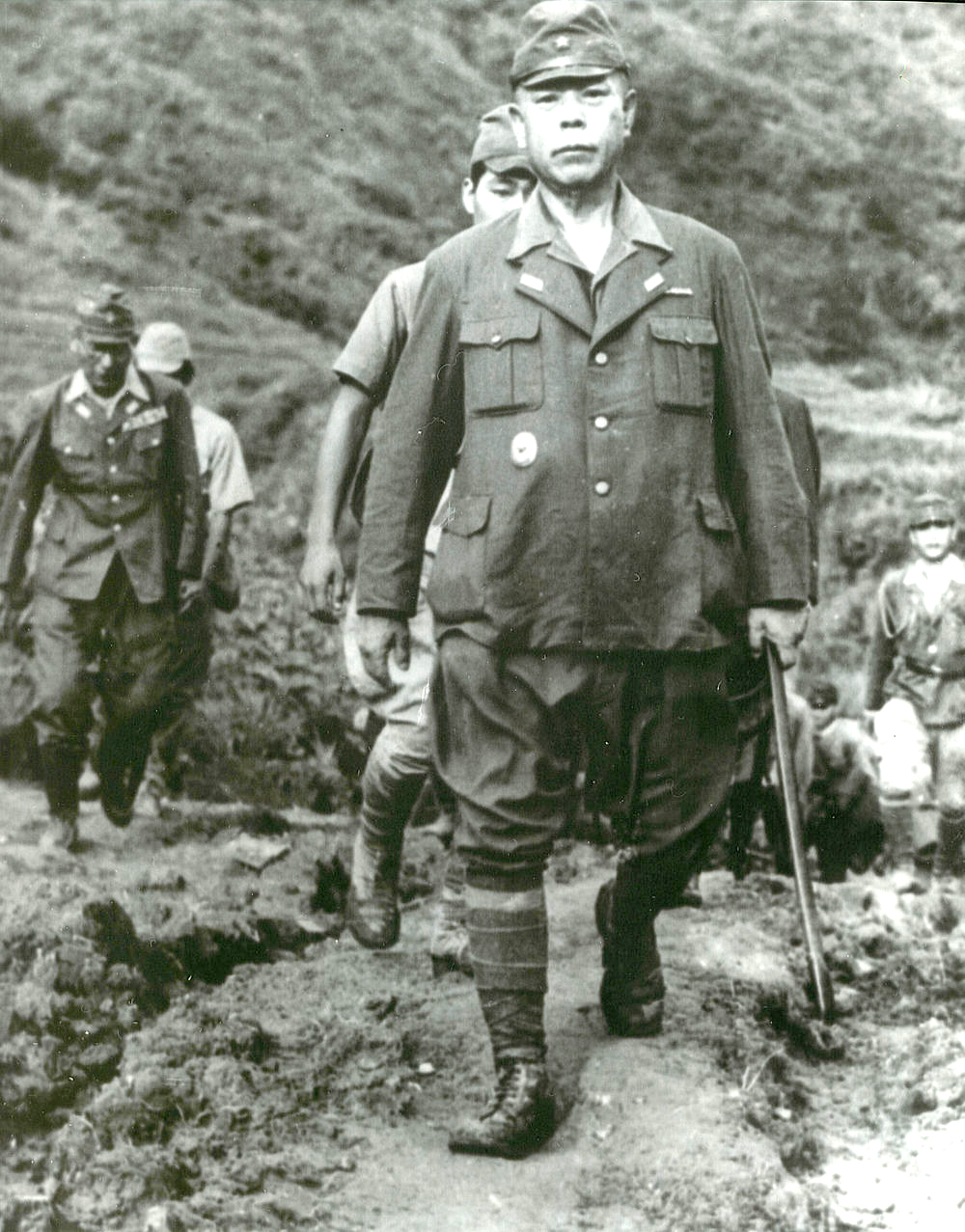 As it stood in early June of 1945, Yamashita (seen in the photo to the right) had already begun enacting the abandonment of the Cagayan Valley itself with a withdrawal into the Cordillera Central. The general planned to spread his forces throughout three defensive perimeters around Luzon's fertile Cagayan Valley which, like an inverted triangle, was encircled on the north by the Babuyan Channel, on the west by the impressive Cordillera Central hills and to the east by the Sierra Madre mountain range. Nicknamed the "Tiger of Malaya" and "The Beast of Bataan", Yamashita had deployed the Shobu Group well around the large valley's perimeter that was a natural stronghold full of gorges and razor-backed ridges and mountain tops. To give his men time to gather and stockpile resources from the valley itself, Yamashita was coordinating a slow "war of attrition" rather than decisive actions with forces that consisted of the 19th Division, the bulk of the 23rd Division, and elements of three others: the 103rd and 10th Divisions and the 2nd Tank Division. Both sides knew that the longer the Japanese had to prepare their defenses, the more casualties it would take to reclaim the Cagayan Valley and the surrounding mountains. It would also allow the enemy to stockpile provisions taken from the productive area since the US Navy had cut off all amphibious enemy resupply (although, again, a Dunkirk-like rescue was a concern, though highly unlikely).
As it stood in early June of 1945, Yamashita (seen in the photo to the right) had already begun enacting the abandonment of the Cagayan Valley itself with a withdrawal into the Cordillera Central. The general planned to spread his forces throughout three defensive perimeters around Luzon's fertile Cagayan Valley which, like an inverted triangle, was encircled on the north by the Babuyan Channel, on the west by the impressive Cordillera Central hills and to the east by the Sierra Madre mountain range. Nicknamed the "Tiger of Malaya" and "The Beast of Bataan", Yamashita had deployed the Shobu Group well around the large valley's perimeter that was a natural stronghold full of gorges and razor-backed ridges and mountain tops. To give his men time to gather and stockpile resources from the valley itself, Yamashita was coordinating a slow "war of attrition" rather than decisive actions with forces that consisted of the 19th Division, the bulk of the 23rd Division, and elements of three others: the 103rd and 10th Divisions and the 2nd Tank Division. Both sides knew that the longer the Japanese had to prepare their defenses, the more casualties it would take to reclaim the Cagayan Valley and the surrounding mountains. It would also allow the enemy to stockpile provisions taken from the productive area since the US Navy had cut off all amphibious enemy resupply (although, again, a Dunkirk-like rescue was a concern, though highly unlikely).
And while the Ohio National Guard’s 37th Infantry, the “Ohio/Buckeye Division”, was tasked with attacking up the valley along Route 5, and to the west Brigadier General Charles E. Hurdis' 6th Division blocked any Japanese trying to escape on Highway 4, US Sixth Army's General Walter Krueger wanted to seal the enemy’s potential escape by sea and box them in for elimination or their surrender. To do so, he elected to send in the 11th Airborne Division for an aerial deployment that would close the Cagayan Valley's northern end. General Krueger hoped this Aparri operation would eliminate one of Japan’s last standing armies in the Philippines and move the Allies one step closer to Tokyo.
As such, on June 21, 1945, General Walter Krueger ordered General Swing to prepare to drop a battalion combat team near Aparri on June 23. Codenamed: The Gypsy Task Force.
God, the Angels and 2 World War II Miracles
Much has been written about the power of faith during times of struggle, including and especially during times of war.
The saying that "There are no atheists in foxholes" holds almost universally true, though the soldiers, sailors, or airmen (or -women) may call their god by different names. It is the provenance of those called upon to fight for their country, or their deity, to find strength in faith (if they so desire), even if it is a faith they had previously forgotten or held with little regard. While in the words of General William Tecumseh Sherman "war is hell", God has the capacity to help the individual warfighter (and civilian) experience the help and strengthening hand of Heaven during his or her service.
The inspirational servant Mother Mary Teresa Bojaxhiu, honored in the Catholic Church as Saint Teresa of Calcutta, once said, "There's nothing more calming in difficult moments than knowing there's someone fighting with you." Anyone who has "felt the rumble of the guns", "heard the snap of the bullets" or "fired in anger" knows intimately the comfort that comes from knowing that you are not fighting alone, and what greater "foxhole buddy" can there be than God?
Countless soldiers can testify as King David did that during their time in combat, "The Lord (was) my strength and my shield; my heart trusted in him, and I (was) helped: therefore my heart greatly rejoiceth; and with my song will I praise him." (Psalms 28:7).
Lady Luck and the Lipa Airstrip Crash
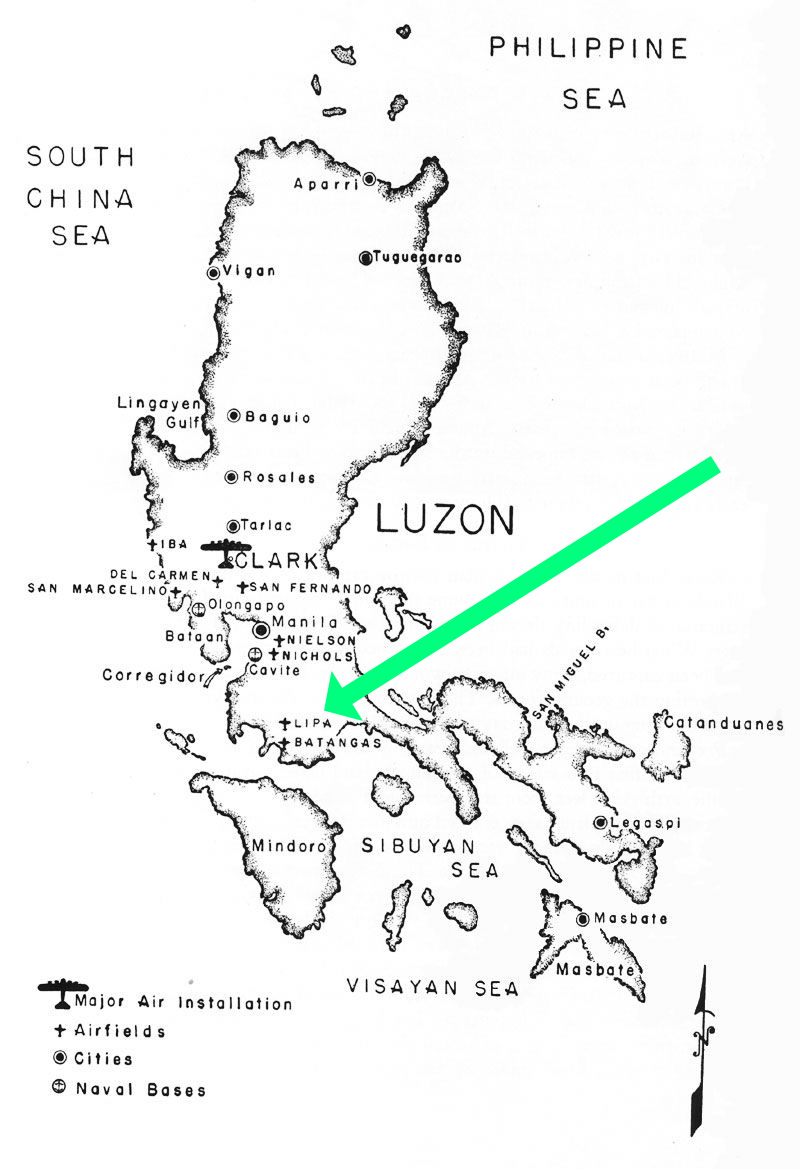 On August 12, 1945, one of the most tragic events in the history of the 11th Airborne Division occurred on what some would consider "an insignificant airbase" at Lipa, Batangas on Luzon, Philippine Archipelago. Outside of native Filipinos, most people don't even know where Lipa is, but over 75 years ago (as of 2021) this event ripped at the heartstrings of an entire division of combat veterans who had already seen so much hell.
On August 12, 1945, one of the most tragic events in the history of the 11th Airborne Division occurred on what some would consider "an insignificant airbase" at Lipa, Batangas on Luzon, Philippine Archipelago. Outside of native Filipinos, most people don't even know where Lipa is, but over 75 years ago (as of 2021) this event ripped at the heartstrings of an entire division of combat veterans who had already seen so much hell.
The 11th Airborne Division, known as "The Angels", had been fighting on Luzon since February and were heavily involved in the retaking of Manila and then southern Luzon. After nearly six months of intense fighting, the Angels were anticipating final operations as the war drew closer and closer to Tokyo's doorstep. The battle-worn division set up at Lipa to integrate replacements and prepare for a jump on either China or Japan itself. Those anticipations changed after COL Paul Tibbets and his Enola Gay crew dropped the first atomic bomb over Hiroshima on August 6, 1945.
Then, at 1158 on August 9, bombardier CPT Kermit Beahan released the 10,800-pound payload nicknamed “Fat Man” over the Urakami Valley. Over 760 miles away in Tokyo the Imperial Supreme War Council was discussing conditional surrender terms and thirty minutes after the debate began, news arrived that a second super bomb had been dropped with another Japanese city utterly destroyed. The next day Japan’s leadership agreed to the Potsdam Ultimatum.
That same day, August 10, the Angels’ radios at Lipa received word that Japan had officially begun peace talks. T-5 L. E. Winenow, a photographer in Division HQ, characterized the Angels’ emotions when he wrote to his family, “To tell the truth, we didn’t do any of the wild celebrating like in the states. It was taken pretty calmly; perhaps because we know the Japs better than any of you folks, and we didn’t dare believe it could be true.”
Many of Read more
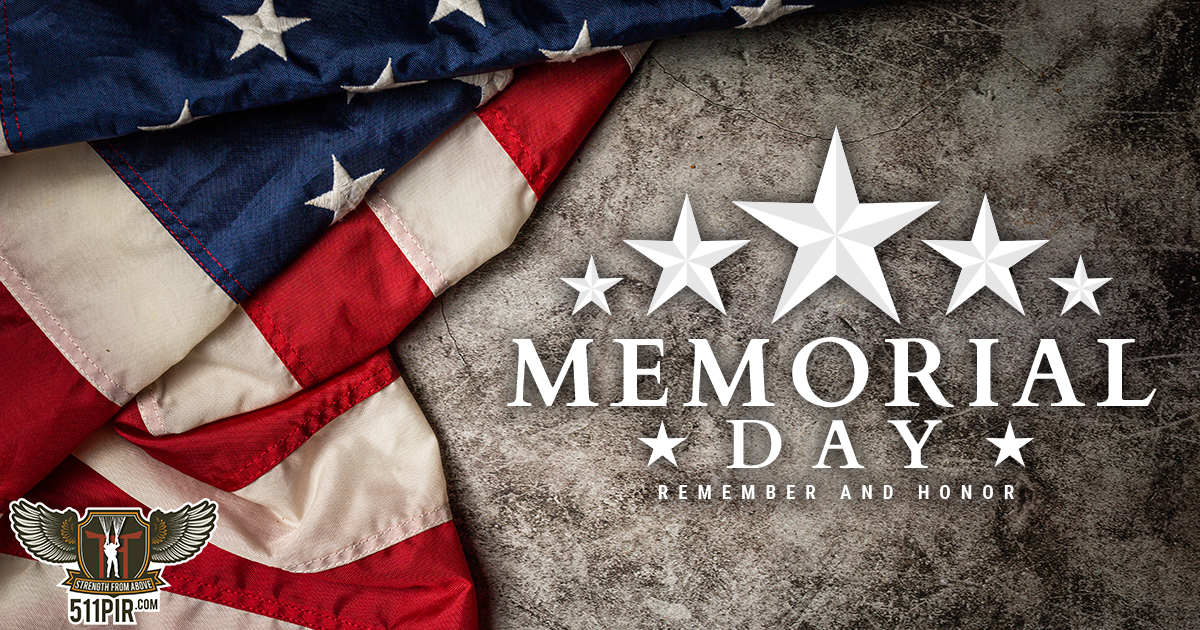
30 Ways to Celebrate Memorial Day
 Growing up my parents both labored to teach me the value of honoring the men and women who have or are serving in America's armed forces. My father is a veteran of the Vietnam War and my mother is a red-white-and-blue-blooded patriotic southerner whose roots go all the way back to Colonel James Barnett who fought in the 6th and 2nd Virginia Regiments which served under General George Washington during the famous Delaware River crossing at Trenton, NJ when Washington's forces rowed across the river to surprise England's Hessian mercenaries on December 26, 1776.
Growing up my parents both labored to teach me the value of honoring the men and women who have or are serving in America's armed forces. My father is a veteran of the Vietnam War and my mother is a red-white-and-blue-blooded patriotic southerner whose roots go all the way back to Colonel James Barnett who fought in the 6th and 2nd Virginia Regiments which served under General George Washington during the famous Delaware River crossing at Trenton, NJ when Washington's forces rowed across the river to surprise England's Hessian mercenaries on December 26, 1776.
Colonel Barnett served his fledgling country until the war's end when he returned to Virginia to enjoy the freedoms that he and his comrades had so recently fought for. They were, and are, freedom which many in my family line have served and sacrificed to protect and defend, from the Revolutionary War to the War of 1812, then the Civil War, at the Alamo, and in World War I and II, Korea, Vietnam, Iraq, Afghanistan and beyond.
Many came home from their respective conflicts; many did not and their bodies lay in states of honor in cemeteries across the nation and around the world. It is a humbling experience to walk the hallowed grounds of Arlington or other American military cemeteries to find the resting places of these ancestors who "gave the ultimate sacrifice" in the service to their country, this country, the United States of America.
I admit that given the cost paid by so many families throughout America's history, a part of me wishes more of my fellow-citizens paid closer attention to the true meaning of Memorial Day, a holiday whose original name almost holds more meaning: Decoration Day. Indeed, one veteran from Indiana spoke those same concerns in 1913 when he lamented that people born after the Civil War had a "tendency... to forget the purpose of Memorial Day and make it a day for games, races and revelry, instead of a day of memory and tears" (yes, some called it "Memorial Day" back then).
Down From Heaven: The 11th Airborne Division Band
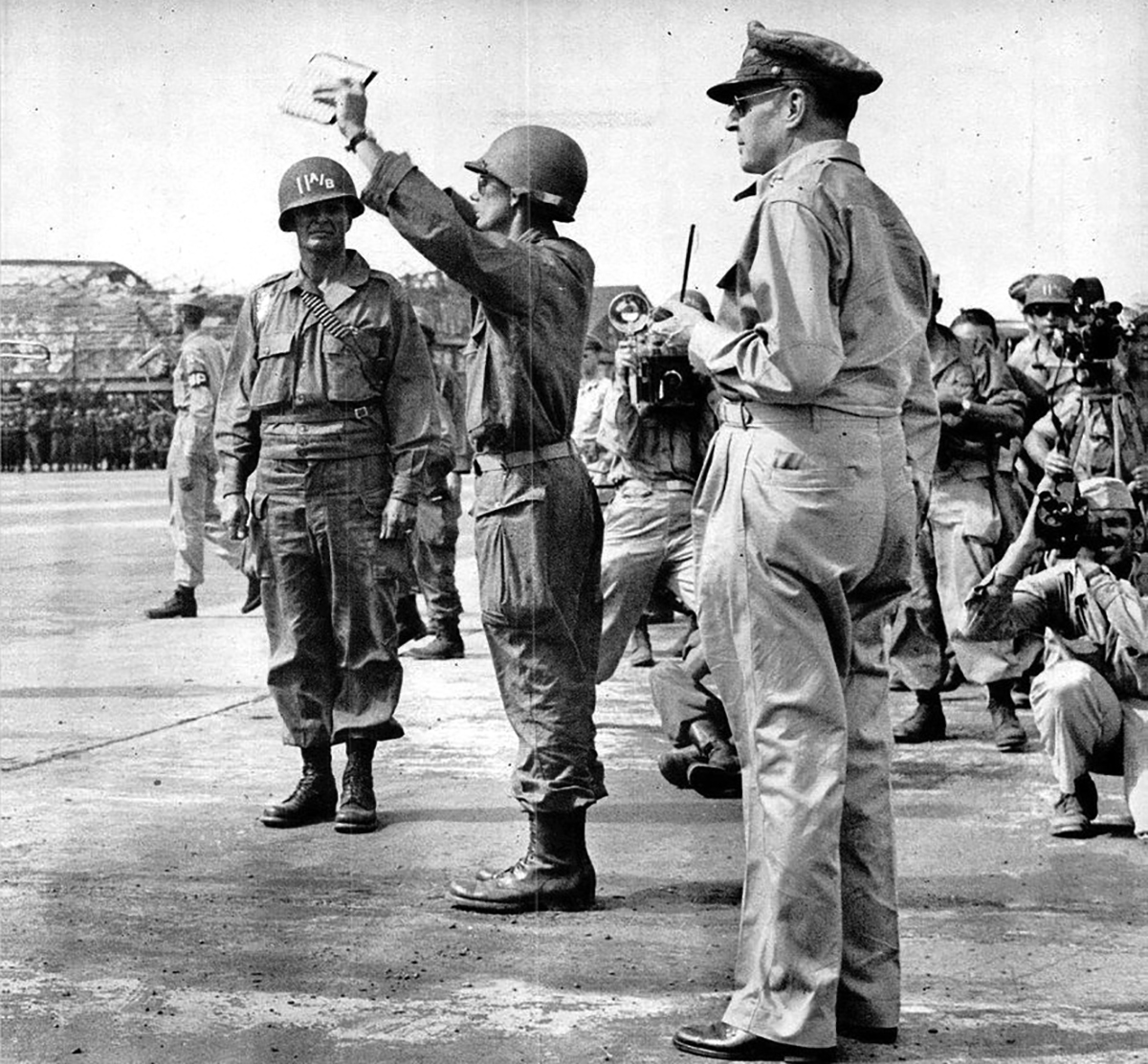 While the mighty 11th Airborne Division served with distinction in World War II and Korea, the division's "theme song" did not come along until the fall of 1950 after the Angels had returned to the United States following Occupation Duty in Japan. A contest was held to encourage the composition of songs and marches that would become anthems of the 11th Airborne Division and perhaps none of the final four entries is as well-known as the marching-ballad (which I'm sure was sung in bars and pubs by Angels since 1950) titled "Down From Heaven", an original song submitted by Colonel Byron Leslie Paige (SSN 376405509, USMA 1932) of Shelby, Michigan. The music that accompanied COL Paige's lyrics was arranged by Sergeant George Whissen.
While the mighty 11th Airborne Division served with distinction in World War II and Korea, the division's "theme song" did not come along until the fall of 1950 after the Angels had returned to the United States following Occupation Duty in Japan. A contest was held to encourage the composition of songs and marches that would become anthems of the 11th Airborne Division and perhaps none of the final four entries is as well-known as the marching-ballad (which I'm sure was sung in bars and pubs by Angels since 1950) titled "Down From Heaven", an original song submitted by Colonel Byron Leslie Paige (SSN 376405509, USMA 1932) of Shelby, Michigan. The music that accompanied COL Paige's lyrics was arranged by Sergeant George Whissen.
Apart from the actual words of the song, the musical component of COL Paige's piece has been lost to history until now. For several decades the division's "old troopers" and a handful of interested historians have had access to the song's words, but I recently came across one of the last (as far as I can tell) recordings of this rousing song on an old vinyl LP recorded by the 11th Airborne Division Band with the 188th Airborne Infantry Regiment Choral Group under W.O. Carroll H. Grummish. Recorded at Reavis Recording Company (2014 Beech Avenue, Nashville, Tennessee), this old record from 1950 was a bit scratchy and dusty, and after several hours of labor I have done my best to digitize and clean up the audio. If you would like a copy of this song, please email me using this website's contact form. -Jeremy Holm
You can listen to the cleaned up copyrighted audio of this song by clicking below. The words of the song are below the player and then a brief history of the 11th Airborne Division Band follows. NOTE: there is also a bonus song titled "Luzon March" that was recorded at the same time in 1950 by the 11th Airborne Division Band and was composed by band-member and future MTNA-fellows Paul Bordeleau of Bedford, New Hampshire.
"Down From Heaven"
BONUS TRACK: "Luzon March"
The Rat's Ass Charge
The Rat's Ass Charge is the story of one of those incredible engagements from World War II, one effected by a small, understrength and under-supported parachute companies, that equals anything that has been written about the incredible exploits of the 101st and 82nd Airborne Divisions in Europe.
That is not said to in any way to diminish what the Screaming Eagles and the All-Americans did "over there." Rather, it is only to point out that the 11th Airborne Division is equally deserving of attention, researching, illumination and praise. This is only a small piece of their story.
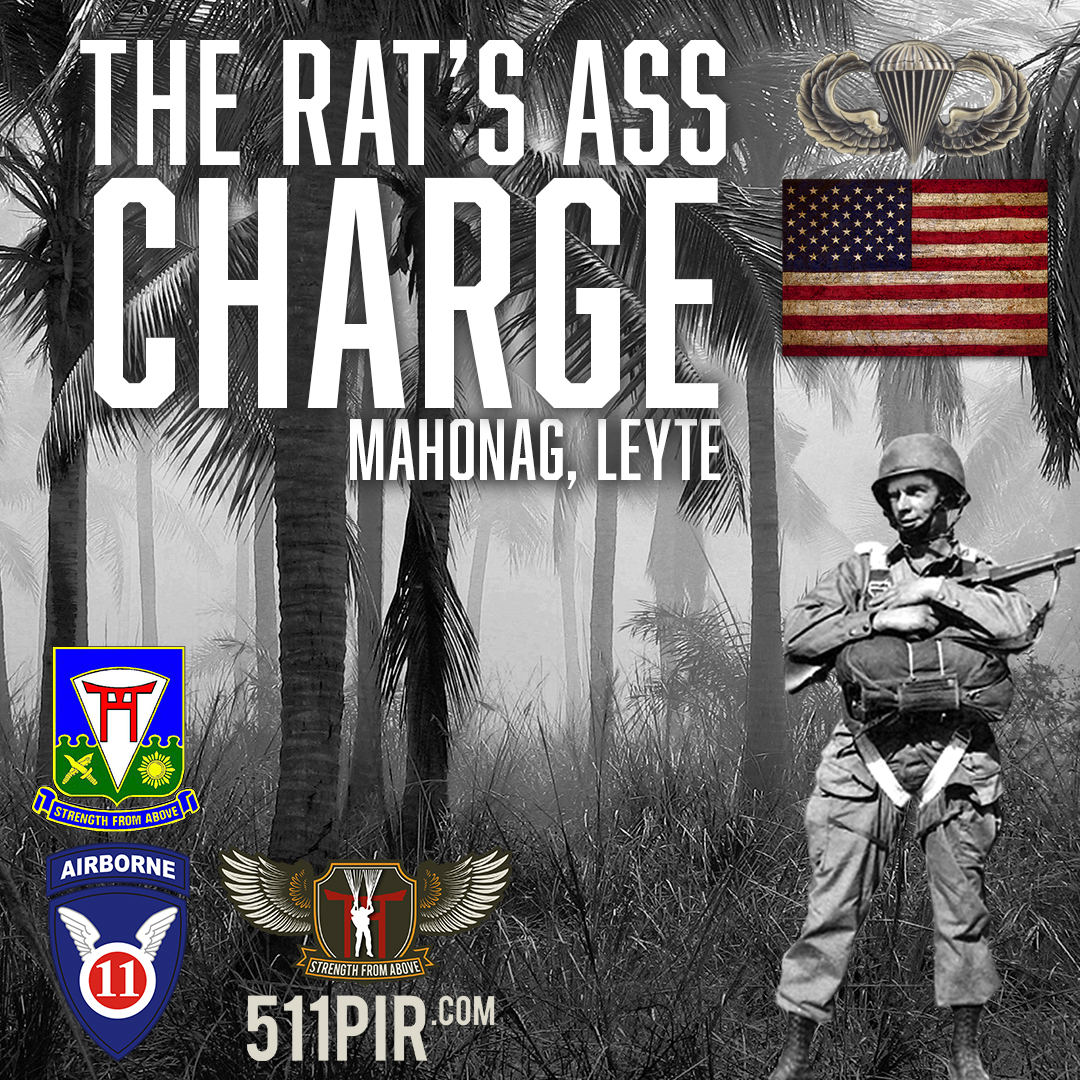 On Thanksgiving Day, 1944, after a breakfast of cold turkey and rain-soaked potatoes and fruit salad, the 511th Parachute Infantry Regiment led the 11th Airborne Division's push westward into the jungles and mountains of Leyte in the Pacific Theater. Over the next 30+ days, the young paratroopers of the 511th PIR would endure the harshest of conditions including hunger, thirst, cold, monsoon rains, Banzai assaults, tropical diseases, blood and death. Many companies went over five days (one up to ten) without resupply and rations and as D Company's 1LT Andrew Carrico later noted, resorted to eating "anything we could find: dogs, roots, potatoes. When you’re hungry you’ll eat anything. Hunger was a constant gnaw in our stomachs."
On Thanksgiving Day, 1944, after a breakfast of cold turkey and rain-soaked potatoes and fruit salad, the 511th Parachute Infantry Regiment led the 11th Airborne Division's push westward into the jungles and mountains of Leyte in the Pacific Theater. Over the next 30+ days, the young paratroopers of the 511th PIR would endure the harshest of conditions including hunger, thirst, cold, monsoon rains, Banzai assaults, tropical diseases, blood and death. Many companies went over five days (one up to ten) without resupply and rations and as D Company's 1LT Andrew Carrico later noted, resorted to eating "anything we could find: dogs, roots, potatoes. When you’re hungry you’ll eat anything. Hunger was a constant gnaw in our stomachs."
Division commander MG Joseph May Swing would later tell his father-in-law Peyton C. March that by mid-campaign, "We’ve killed over 2000 Japanese…” in what Swing called “a process of extermination...Casualties on our side are not light..."
Not light indeed; the 511th PIR was down to just 60% strength, having suffered over 400 casualties in roughly three weeks, roughly 75% of the Division’s losses, while eliminating 5,760 soldiers of Japan’s 26th and 16th Infantry Divisions. When they marched down to Ormoc Bay on Leyte's western coast on Christmas Day, Captain Stephen Edward Cavanaugh explained, "We came out on the other side of the island a pretty well decimated regiment." Cavanaugh's D Company left Leyte's Bito Beach on November 23 with 117 men; twenty-one of their comrades now lay dead in the mountains or were being carried out on poncho stretchers.
The photo to the right is of the 511th PIR's cemetery on what they called Rock Hill because "he was there," he being their regimental commander Colonel Orin D. "Hard Rock" Haugen who was right up front with them. After fighting by their side through several engagements, Colonel Haugen had gained a reputation as a serious fighter.
All of his paratroopers had, actually. Sixth Army's Lieutenant General Walter C. Krueger called Hard Rock's unit, "the God-damned fightingest outfit I have ever seen!"
But by December 21, 1944, that "fightingest outfit" was still miles away from the beaches of Ormoc Bay with a stubborn line of enemy defenses standing in their way. COL Haugen, fresh from a late meeting with MG Swing, decided an early attack would be the most effective means of eliminating Hacksaw Ridge’s last defenders, and for good reason. As D Company's 1LT Carrico explained, "The Japanese were famous for sleeping late."
Hard Rock also told his men to shave and clean up since MG Swing would soon come through with the 187th Glider Infantry Regiment, which led D Company's S/Sgt. Wilbur Wilcox, Wilbur to declare, "Scraping a month’s growth of beard off was agony!"
The Battle for Mt. Bijang
The Battle for Luzon's Mount Bijang (also Bijiang), located about 40 miles south-east of Manila is one of those obscure combat engagements that the world has passed over simply because World War II was full of tens of thousands of such operations on land, the seas and in the air.
As any military historian (or even casual student) can tell you, these battles were often fought by men, frequently young men, who found deep wells of courage in the heat of battle in a mixture of adrenaline, duty, will, and an unrelenting desire to do their best for their buddies.
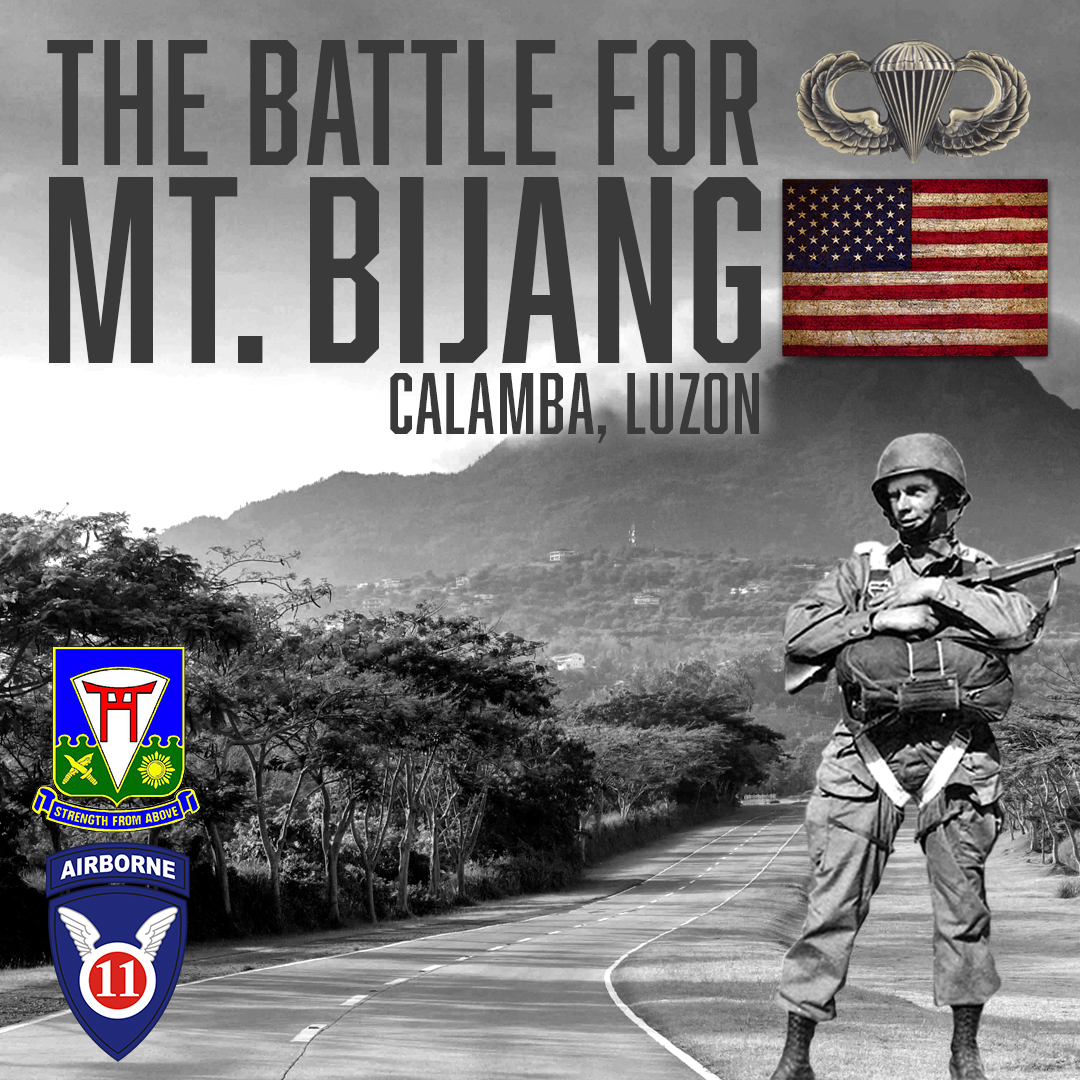 The Battle for Mt. Bijang is the story of one understrength parachute company in their fight to take and retain what their company commander called, "an insignificant piece of real estate" against an estimated 300 Japanese defenders. I have heard from the paratroopers who were there, including that company commander, and from my own grandfather, 1LT Andrew Carrico III who was serving as Company Executive Officer at the time and was wounded so badly that some in D Company thought he was killed. The Battle for Mt. Bijang was one of those "small-unit operations" that displays the effects of superb leadership, skilled NCOs, determined frontline fighters and one unit's unwillingness to let each other down.
The Battle for Mt. Bijang is the story of one understrength parachute company in their fight to take and retain what their company commander called, "an insignificant piece of real estate" against an estimated 300 Japanese defenders. I have heard from the paratroopers who were there, including that company commander, and from my own grandfather, 1LT Andrew Carrico III who was serving as Company Executive Officer at the time and was wounded so badly that some in D Company thought he was killed. The Battle for Mt. Bijang was one of those "small-unit operations" that displays the effects of superb leadership, skilled NCOs, determined frontline fighters and one unit's unwillingness to let each other down.
Battle Background
On February 3, 1945, the 511th Parachute Infantry Regiment dropped on Luzon's Tagaytay Ridge just south of Manila, then pushed north up into the city. Grandpa's D Company, the same unit that fought the Battle for Mt. Bijang, was selected to spearhead the 11th Airborne Division's drive into Manila and Grandpa explained, "Here we are, a little old airborne division with its 8,000 men attacking Manila from the South and the 1st Calvary Division with its 20,000 men attacking from the North and (my) 1st Platoon, D Company out in front of everybody! Quite an Experience."
He then chuckled and said, "My squad leaders all asked, 'Why do we get all the dirty jobs?!'"
The Battle for Manila would prove to be bloody for Major-General Joseph May Swing's understrength 11th Airborne Division, including D Company which would be the first Angels to encounter the enemy at Imus, just outside Manila proper (a story for another day!). In 1949, COL Edward H. "Slugger" Lahti, CO of the 511th PIR, explained that the regiment's 2nd Battalion (which included D Company) had landed on Tagaytay Ridge on February 3, 1945 with 502 men. By February 10, one week later, the battalion was down to just 187 effective officers and enlisted men.
On February 10, the battle-worn men of D Company were given a break from the lines and twenty-three-year-old Captain Stephen Edward "Rusty" Cavanaugh selected an assembly point for D Company several hundred yards to the rear near the Parañaque Bridge where they could clean up and get a hot meal. As his troopers moved back, the fatigued captain grew frustrated with what appeared to be a delay in assembly. Nerves frayed from a week of combat (during which he slept very little), Cavanaugh chewed out his new 1SGT Paul R. Farnsworth for the men’s sluggishness.
With a pained look in his eyes, Farnsworth quietly replied, “Sir, that’s all there is.” Everyone else was gone.
President Ronald Reagan's message for the 511th Parachute Infantry Regiment
THE WHITE HOUSE
WASHINGTON
August 12, 1988
It gives me great pleasure to send warm greetings to members of the 511th Parachute Infantry Association as you meet in Valley Forge for your 45th annual reunion.
Each of you has gone his separate way in the world, but--as this reunion proves once again -- your service and sacrifice together forged a bond of fellowship that time and distance cannot break. Together you confronted danger and endured terrible hardships, and together you rose to the challenge; you never faltered. Many of your brothers gave their last full measure of devotion so that others might live in freedom. Your accomplishments in defense of liberty will never be forgotten, and America's debt to you will remain far more than we can ever repay.
I take a moment with you to honor your brothers who can no longer answer roll call. God bless you all.
Ronald Reagan
The 511th PIR on New Guinea: Part 1
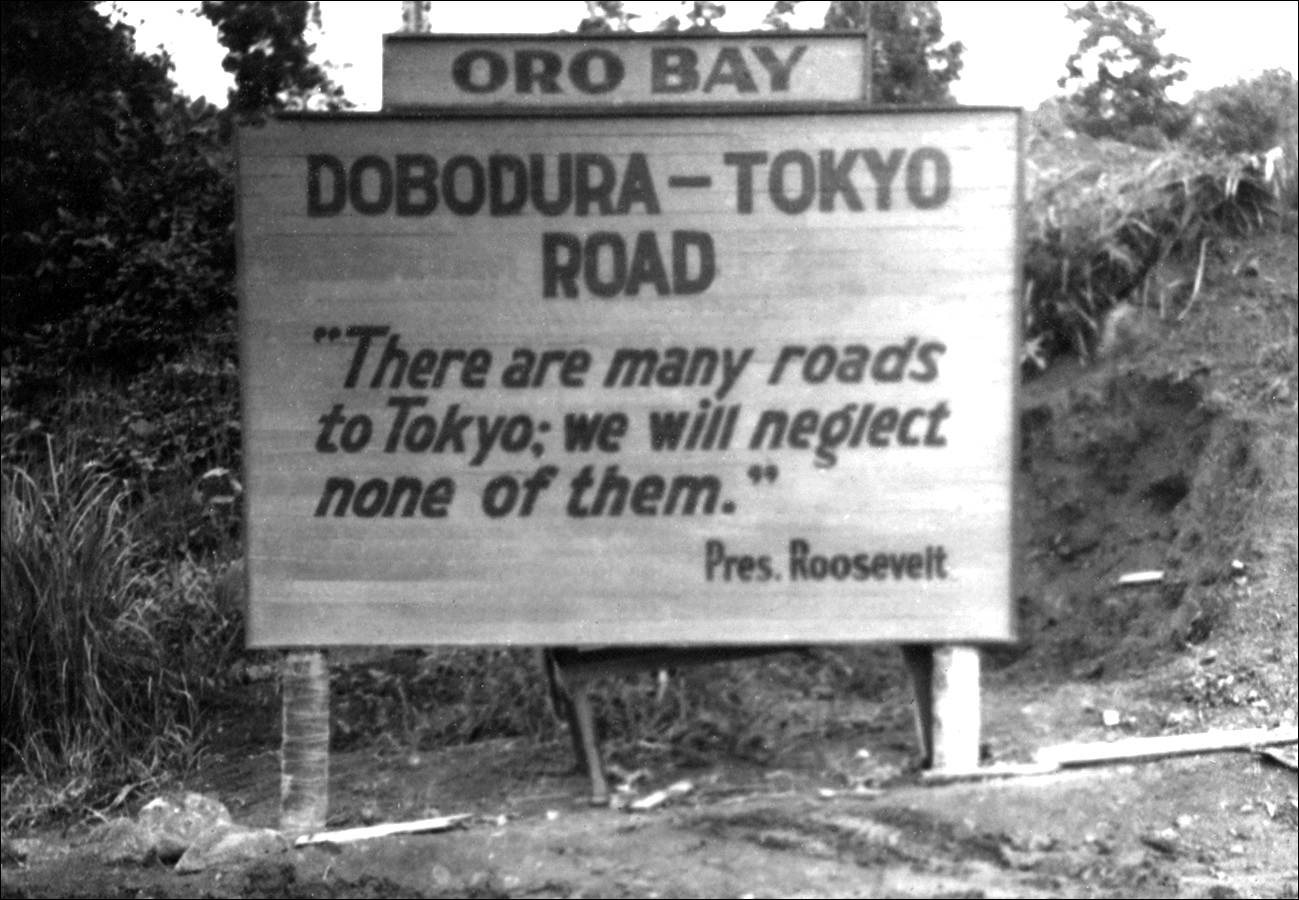 I've received several inquiries lately about what Colonel Orin D. "Hard Rock" Haugen's 511th Parachute Infantry Regiment (and the 11th Airborne Division as a whole) did while they were stationed at Dobodura, New Guinea between May and November of 1944 and thought I would paint a portion of that particular picture here.
I've received several inquiries lately about what Colonel Orin D. "Hard Rock" Haugen's 511th Parachute Infantry Regiment (and the 11th Airborne Division as a whole) did while they were stationed at Dobodura, New Guinea between May and November of 1944 and thought I would paint a portion of that particular picture here.
When the regiment arrived at Oro Bay on May 28, 1944 they got their first real look at the lush green mountains of the Pacific's islands with a relatively short stop-over in Milne Bay (either at Aihoma or Waga Waga) where the Angels' transport, the much-hated SS Sea Pike, off-loaded some cargo and took on fresh water and fuel. During the activities, the dock workers regaled the fresh paratroopers with stories of the battles for New Guinea which had been raging since January of 1942, over two years earlier. Some of the workers even told the Angels that they daily patrolled the jungles around the docks just to shoot enemy stragglers.
Col. Haugen's cocky, yet inexperienced, boys ate it up, of course.
Welcome to Dobodura
After a local pilot came onboard, the Sea Pike sailed some 160-miles north for Oro Bay where the young paratroopers flooded the decks to study the massive Allied fleets that filled Oro Bay's picturesque waters. It is possible that the 511th disembarked on the bay's southern shores where a Liberty Ship wharf had been built, but I doubt it as the paratroopers had to climb down cargo nets into waiting DUKWs which circled the ship off shore (there were also LST landings at Embogo to the north). The DUKWs then motored up the beach and drove the Angels several miles inland past Allied supply dumps and warehouses which piqued the paratroopers' curiosity. As their months on New Guinea droned on, the young paratroopers would make countless "Midnight Requisition" trips to steal untold amounts of rations, weapons, ammunition, and carefully parked vehicles including jeeps, ambulances, bulldozers and even Kenworth 10-ton 6x6 heavy wrecking trucks. More on that later!
"Victory for the U.S.A." - Poem by World War II veteran of the 457th Parachute Field Artillery Battalion
This poem was written during the war
by Private Bronnell York
Battery D, 457th Parachute Field Artillery Battalion
APO #468, %Postmaster
San Francisco, Calif
We're the boys of the 457,
Earning our major pay,
Fighting Japs and jungle life,
For three sixty cents a day.
Back we're soon forgotten,
By girls and friends we knew,
Here in the South Sea Islands,
Ten thousand miles from home.
All night the rains keep falling,
It's more than we can stand,
"No", folks, we're not convicts,
We're defenders of our land.
We're the boys of many,
Holding the upper hand,
Hitting the silk and hoping,
We're living when we land
We're having it pretty tough now,
You can believe what I say,
Some day we hope to live again,
Back home in the U.S.A.
The Landings at Atsugi, Japan on August 30, 1945
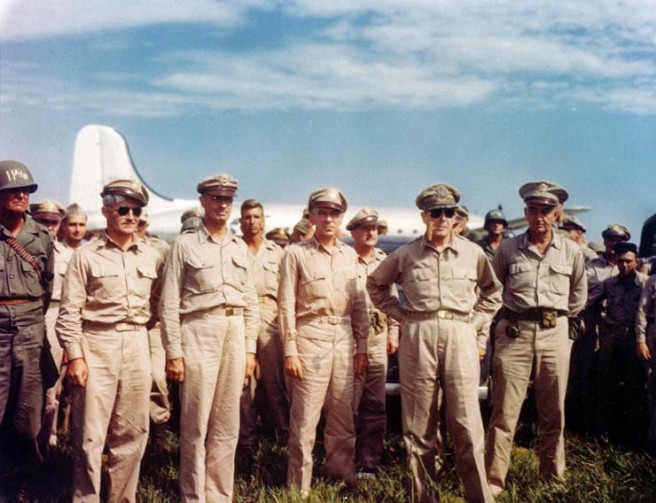 After my grandfather, 1LT Andrew Carrico of Company D, passed away in October of 2016, my beloved grandmother Jane gave me some of his books on military history and leadership. They are a special part of my collection, but the funny thing is....Grandpa really disliked some of them. He was painfully aware of just how few of the tens of thousands of books published on World War II even mention the 11th Airborne Division, let alone his proud 511th Parachute Infantry Regiment (you can likely count them on two hands)
After my grandfather, 1LT Andrew Carrico of Company D, passed away in October of 2016, my beloved grandmother Jane gave me some of his books on military history and leadership. They are a special part of my collection, but the funny thing is....Grandpa really disliked some of them. He was painfully aware of just how few of the tens of thousands of books published on World War II even mention the 11th Airborne Division, let alone his proud 511th Parachute Infantry Regiment (you can likely count them on two hands)
When Grandma shared Grandpa's books with me, she pointed to one with a smile and said, "Andy hated that one. It doesn't even mention the 11th." And as a historian for the 511th PIR, and the 11th Airborne as a whole, I have to agree with Andy. While researching, writing and publishing WHEN ANGELS FALL: FROM TOCCOA TO TOKYO, THE 511TH PARACHUTE INFANTRY IN WORLD WAR II, I found myself disappointed by the lack of media coverage regarding the Angels' history (I admit to some bias there).
One of the most important aspects of the Angels' history that is hardly mentioned anywhere is their incredible landings at Atsugi, Japan between August 28-30, 1945. Apart from further cementing the reality of the war's end, this made the 511th Parachute Infantry Regiment the first fully-formed foreign regiment to land on Japan in the country's long history, not to mention the first Allied unit into Japan at the war's end.
"We're Going to Japan"
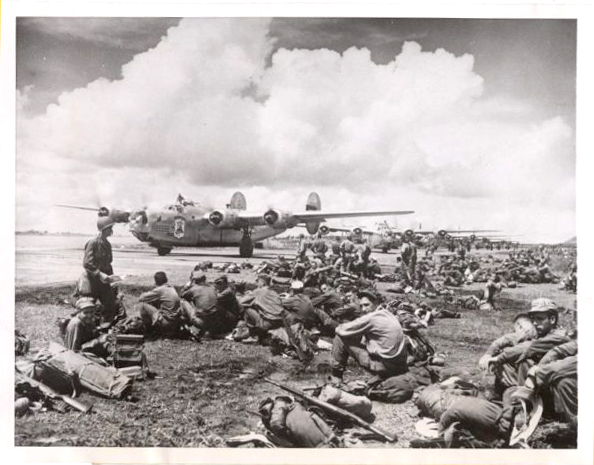 When Japan announced their intention to surrender on August 14, 1945, Major General Joseph May Swing's 11th Airborne Division sat, bored, on Okinawa near the National Cemetery, asking themselves if the surrender was all just a ruse to lure them onto the mainland only to destroy the first Americans to land. And since they were an airborne division, the Angels felt that they would indeed be some of those first "sacrificial lambs" sent in to secure some crucial target(s) or another.
When Japan announced their intention to surrender on August 14, 1945, Major General Joseph May Swing's 11th Airborne Division sat, bored, on Okinawa near the National Cemetery, asking themselves if the surrender was all just a ruse to lure them onto the mainland only to destroy the first Americans to land. And since they were an airborne division, the Angels felt that they would indeed be some of those first "sacrificial lambs" sent in to secure some crucial target(s) or another.
Before the surrender was announced, however, the waiting Angels were somewhat “hellbent for election” according to one trooper. Even so, General Swing's men questioned if they would make it through the potential invasion on Japan, should the operation be called for. Leyte and Luzon had both bled the 511th PIR sorely and the paratroopers who had managed to survive both campaigns quietly wondered if the "third time was the unlucky charm."
But that didn't stop General "Jumpin' Joe" Swing from walking into the hospital treating many of his Luzon wounded and booming, “I want every man that can walk…out of here today. We’re leaving the island; we’re going to Japan.”
General Swing's battle-worn Angels were ready for the war's end and while all were ready to do their duty if called upon to jump on mainland Japan, no one shed any tears when news of the atomic bombs' destruction at Hiroshima and Nagasaki spread through the Division's Okinawa camps. But there wasn't any wild celebrating either; the Angels had fought Imperial Japan too long to believe that the enemy was ready to throw in the towel just yet.
In truth, many were and another firebombing raid on Tokyo on August 14 sealed the decision. Before the last aircraft returned, Japan surrendered and President Harry S. Truman declared to reporters at the White House, “This is the day we have been waiting for since Pearl Harbor. This is the day when Fascism finally dies, as we always knew it would.”
“Victory in Japan Day”, or “VJ-Day”, celebrations erupted around the world from London to Luzon, Pearl Harbor to Paris, and New York to New Guinea. But on Okinawa, the Angels took several test jumps from modified B-24 bombers since a C-46’s fuel tanks could not make it to Tokyo and back with an acceptable margin of safety. The B-24s were quickly rejected as they lacked sizeable jump doors and could not slow down enough for safe jumping. In the end, Douglas C-54 Skymasters were selected as the Angels’ main source of conveyance and since most of the C-54s were commercial, the 511th’s paratroopers were beyond pleased to see ten rows of comfortable seats.
Second Battalion Officers' Photo
Officers of 2nd Battalion
1943
511 Parachute Infantry
Camp McCall
Note: Click photo to enlarge. McCall mispelling above is on original photo. All names listed are from the photo's left to right and units are listed at time photo was taken
Row 1:
1LT Lemuel T. Pitts (E Co); 1LT Edwin B. Jeffrees Sr. (F Co); Capt. Matthew Platt, MD (Battalion surgeon / 511th Medical Detachment); 1LT John W. Norwalk (F Co); Capt. Charles E. "Baldy" Jenkins (CO HQ2); Maj. Wallace L. Chambers (Regimental surgeon / CO 511th Medical Detachment); LTC Norman Shipley (CO 2nd Battalion); Capt. Lyman S. Faulkner (CO D Co); Capt. Hobert B. Wade (CO E Co); ? Rath; ? Marshall; 1LT C. A. Disney (HQ2).
Row 2:
2LT Randolph W. Kirkland (HQ2); 2LT R. T. Alsbury (HQ2); 1LT I. N. Raphael (HQ2); 2LT Robert Norris (HQ2); 2LT R. O. Macey (HQ2); 2LT R. W. Buckholt (HQ2); 2LT W. Ackerman; 1LT A. Fred Renaud (E Co); 1LT Winfred H. Samuels (F Co); 2LT William J. Light (D Co); 2LT G. L. Abernathy (D Co); 2LT H. J. Reid (HQ2); 2LT R. R. Culberston; 2LT L. C. Hover.
Row 3:
2LT Ralph E. Ermantinger (F Co); 1LT Andrew Carrico (D Co); 2LT Ernest H. "Bud" Martin (F Co); 2Lt L. C. Manley (F Co); 1LT William E. Nellist (F Co); 1LT T. W. Brady (E Co); 1LT Patrick W. Wheeler (HQ2); 1LT Thomas A. Meserau (E Co); 2LT Glenn W. Freeman (F Co); ? Clark; 2LT Walter E. Kannelly (D Co); ? Moore; 1Lt Thomas P. Gannon (E Co); 2LT W. C. Joyner; 2LT Leo Crawford (HQ2); 1LT Francis P. Solomon (D Co).
Dr. Dana Nance and The Sacred Eleven Nurses of Corregidor, Santo Tomas and Los Baños
Error
Seventy-five years ago on February 23, 1945 the 511th Parachute Infantry Regiment and the 11th Airborne Division ("The Angels") conducted their famous raid on the Los Baños internment camp on Luzon, Philippines. It is, perhaps, the regiment's most well-known operation (although their history is full of incredible campaigns). At Los Baños, the Angels were willing to risk heavy losses to rescue the 2,100+ men, women and children who had been prisoners of the Imperial Japanese forces since early 1942, so roughly three years. After the 11th Airborne landed on Luzon in late January and early February of 1945, Major General Joseph May Swing was tasked with effecting a rescue of the civilians held at the camp. The problem was that in early- and mid-February General Swing's Angels were heavily engaged in the fight for Manila and therefore he could not commit a force of sufficient size to conduct the raid for now. The internees would have to wait a few weeks more.
Despite horrendous conditions in the camp under the Imperial Japanese guards, the internees at Los Baños were in good hands, some would even say miracle-effecting hands. No, I am not referring to the camp's abundance of clergy who, after arriving in July of 1944, labored to keep up the spirits (and faith) of the internees (although some refused to help with the sick in the camp).
Rather, I am referring to the expert care and attention given to the men, women and children by the camp's doctors and their well-known attendants, The Sacred Eleven, eleven US Navy nurses who had been stationed at Sangley Point's Canacao Naval Hospital at the Cavite Naval Yards on Manila Bay and helped the wounded during the invasion of Manila in 1941. After US military forces were surrendered to the Japanese on January 2, 1942, The Sacred Eleven became prisoners and were first interned at the Santo Tomas Internment Camp before volunteering to transfer to the Los Baños Internment Camp in May of 1943 to help with the “hospital” there (even they would agree that given the camp's conditions it was only a hospital by the loosest of definitions).
Of note, the US Army nurses stationed at Santo Tomas refused to go to Los Baños. When Chief Nurse Laura Mae Cobb, who is the only chief nurse in navy medical history to continue her duties while in enemy captivity, asked her Navy nurses if they were willing to risk it, they all agreed. On the morning the nurses left Santo Tomas, someone managed to play “Anchors Aweigh” on the camp PA system to honor their spirit.
The Los Baños Raid Mission Timeline
"This operation will remain in military history as a classic example of the use of airborne troops to achieve tactical surprise." -Lieutenant-General William P. Yarborough, 1989.
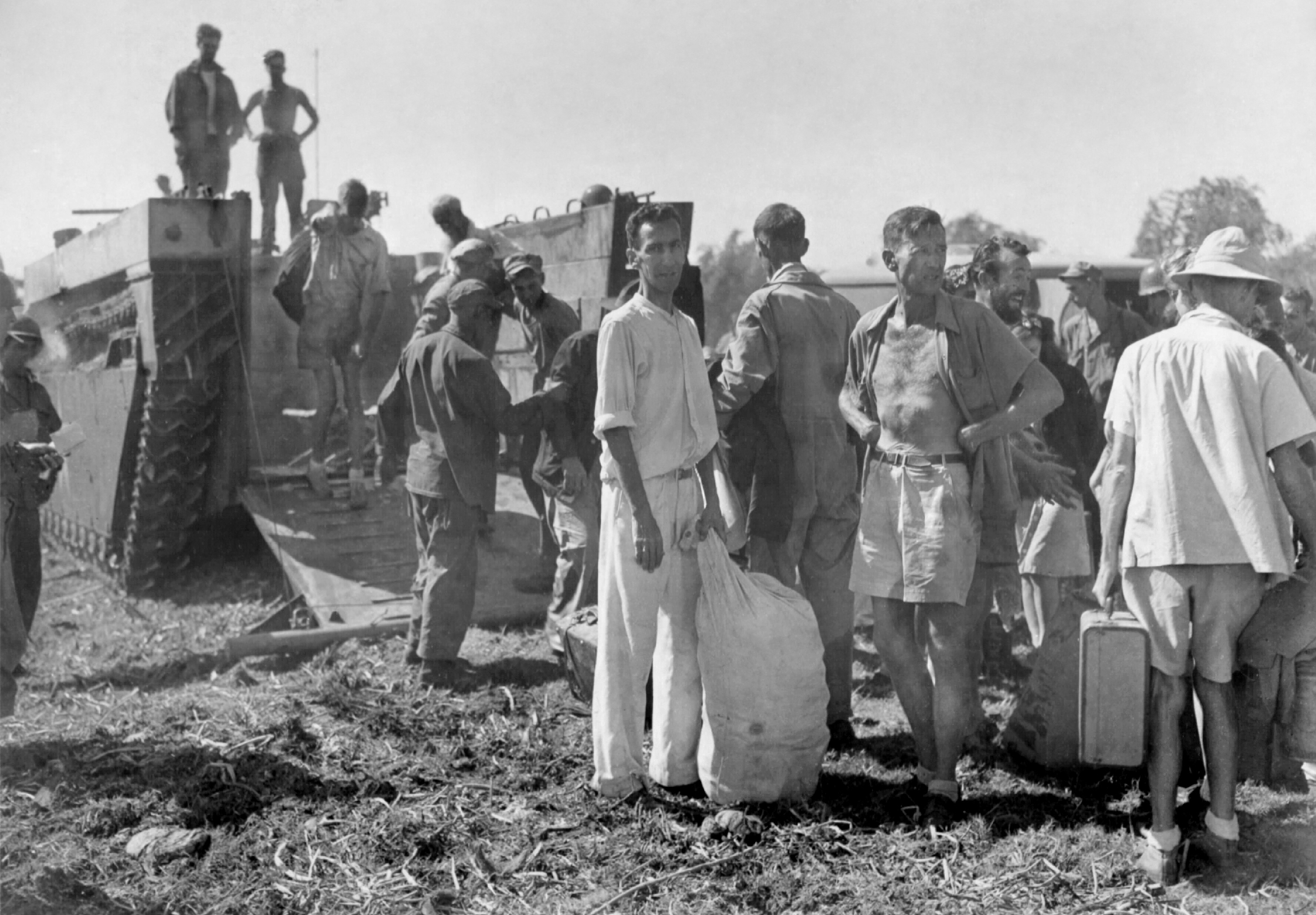 Note: This timeline is an attempt to cover the major aspects of this historic operation by date/time. It will not cover every facet or key player of the raid in detail for to do so would require (and has) an entire book. If you would like to read the full story of this mission, you may do so in my book, “When Angels Fall: From Toccoa to Tokyo, the 511th Parachute Infantry Regiment in World War II”
Note: This timeline is an attempt to cover the major aspects of this historic operation by date/time. It will not cover every facet or key player of the raid in detail for to do so would require (and has) an entire book. If you would like to read the full story of this mission, you may do so in my book, “When Angels Fall: From Toccoa to Tokyo, the 511th Parachute Infantry Regiment in World War II”
I would like to give a special thank-you to Col. Edward H. Lahti who was CO of the 511th Parachute Infantry Regiment at the time of the raid and whose papers I am in possession of.
An equally large thank-you is due to retired Brigadier-General Henry “Hank” Muller who was so integral to the raid’s success and in helping compile this timeline of the operation. He truly is “an officer and a gentleman”.
Finally, I must thank my friend Robert Wheeler who was a young child when the Angels rescued his family from Los Baños. His insights into the raid have proven invaluable.
To any outlets, historians, re-enactors, etc. who use the information in this timeline, please list myself as author and credit www.511pir.com – Jeremy C. Holm
Notice for Transfer from Santo Tomas to Los Baños Internment Camps
(Originally posted on May 8, 1945 at the Santo Tomas Internment Camp, Manila, Luzon)
This afternoon the Commandant of the Camp issued the following statement to the Executive Committee:
I am authorized by the Director-General of the Japanese Military Administration in the Philippines to make a statement regarding the change of location of enemy civilian's internment camp.
As all of you are well aware, released enemy nationals in the city of Manila are more than 2,000. Most of them, being unemployed, are in extreme difficulties in their living, and the number of applicants for internment is daily increasing. It is, however, to be pointed out that the present accommodations available in the Santo Tomas Internment Camp is not sufficient to have all of them interned there, and particularly so from sanitary point of view.
In consideration of these facts, the Military Authorities here have come to a decision, to change the location of the internment camp to a more spacious place where more permanent accommodations can be provided so that you will continue to live there until the time when you will repatriate to your respective countries or peace will be restored.
The new site is in Los Baños, Laguna, an ideal health resort noted for its hot springs, where new buildings will be erected for your housing and where you will enjoy fresh air and find easy access to fresh meat and vegetables, part of which you may be able to cultivate yourselves.
In carrying out the above plan, the first group of about 800 men to be selected from the present internees, which will constitute the core for the new camp, will be dispatched to Los Baños by trains on the 14th of the month. For this first group, the premises of the Agriculture College including its large track field will be available.
It is to be emphasized that this change of location is entirely based upon the humanitarian consideration of your own welfare, and that fairness to the treatment to be accorded to internees shall always be maintained.
In this connection, you are cautioned not to make and careless utterances which will distort the true intention of the Military Administration regarding the present plan, as they are sure that the new camp will promise a better and healthier life to all the enemy civilians in this country
Finally the authorities hope that the Executive Committee and all internees will render full cooperation in carrying out the above program.
Los Baños Raid Photos & Resources
Documents list and videos below photo gallery - View Complete Operation Timeline Here
Error
Who Was Colonel Orin D. "Hard Rock" Haugen? Part 2
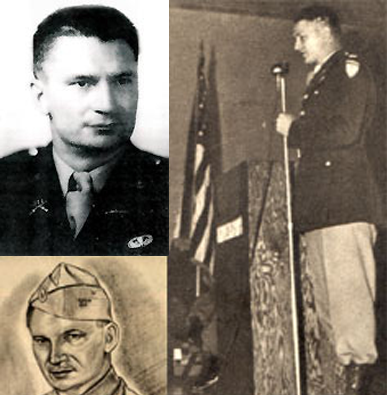 This is Part 2 of our series on the legendary Colonel Orin D. "Hard Rock" Haugen #18254. You can read "Part 1: Who Was Colonel Orin D. "Hard Rock" Haugen?" by clicking here.
This is Part 2 of our series on the legendary Colonel Orin D. "Hard Rock" Haugen #18254. You can read "Part 1: Who Was Colonel Orin D. "Hard Rock" Haugen?" by clicking here.
While there is an unfortunate scarcity of research out there in regards to the 511th Parachute Infantry Regiment, and the 11th Airborne Division to which the 511th PIR belonged, there has been even less written or documented regarding the men who fought as Angels in World War II. While the 511th PIR served under two leaders during the war whom were greatly revered, the man who laid the foundation for the regiment's historic achievements was given an appropriate nickname for such accomplishments: Hard Rock.
Camp Mackall
Four days after Colonel Orin D. Haugen's 511th Parachute Infantry Regiment closed on North Carolina's Camp Mackall in March of 1943, they became the first fully-formed unit of Major-General Swing, Joseph May's new 11th Airborne Division, the first unit to headquartered at the new camp.
Opened just six weeks prior to the 511th’s arrival, the 56,000-acre post (a sub-installation of Fort Bragg) was originally named Camp Hoffman after the nearby rail station. On February 8, the War Department issued General Order Number 6 renaming the post after Private John T. Mackall, a paratrooper from the 503rd PIR killed by strafing Vichy French fighters during Operation Torch (John was wounded on November 8, the same day construction on the camp began, then died three days later).
When Colonel Haugen’s regiment arrived at Mackall, they found their new beds spotlessly made by the barrack’s previous tenants, the 82nd Airborne’s 504 and 505 PIRs. The luxuries did not last as Hard Rock ordered their clean, white sheets replaced with rough wool blankets. His paratroopers thought the actions harsh until they discovered that their small coal-fed heaters were less-than-adequate against the night’s chill (those bunking far from the stoves stoked them red hot at night which singed the eyebrows of the closer men).
Haugen’s young regiment was joined at Mackall by the 457th Parachute Field Artillery Battalion and the 187th and 188th Glider Infantry Regiments. Of the original 12,000 men who volunteered for the 511th, only 2,176 remained (2,000 enlisted, 173 officers and three warrant officers). Camp Toccoa’s endless PT, Haugen's enthusiastically-supported brutal runs on Currahee, the mock jump towers, and Hard Rock's demands for excellence had eliminated nearly 10,000 men who did not meet the Colonel's standards.
And yet, unlike their Commanding Officer, most of the men were not yet paratroopers and while they could wear parachutist patches on their garrison caps, they had yet to earn their jump wings. That was about to change. While Colonel Haugen's cadre fought to select who would serve as their NCOs and in their squads, Hard Rock decided to give his regiment one final test before jump school. Orin ordered a two-week bivouac maneuver that included a twenty-five-mile march out to the mission area where the 511th lived in pup tents and participated in several combat simulations and problems. The last night was spent hiking the twenty-five miles back to Mackall in full kits.
Averaging five miles an hour, the men were told that if they fell out, they would be transferred. Given that many were suffering from dysentery at the time, the march was doubly challenging, yet the regiment finished Haugen’s exam. When the column passed through Mackall’s gates and turned into the 511th’s area, Col. Haugen and his staff stood proudly outside RHQ where Hard Rock loudly proclaimed his congratulations for a job well done.
“It almost made it worthwhile!” commented D Company’s new Company Mail Orderly Cpl. Murray Hale, reminding us of Orin's penchant for withholding praise. Not because he didn't care or was oblivious to his men's accomplishments, but rather because it just wasn't his style.
After three additional months of training under Haugen's watchful eye, the 511th changed locale once more and this time his men felt greater anticipation.
“We were on a high all the time,” Private First Class Billy Pettit explained.
On May 14, Orin's regiment loaded into trucks for the six-hour trip to Fort Benning’s parachute school.
MacArthur's Angels: Mac & the 11th Airborne Division
 With the anniversary of General Douglas MacArthur's death (January 26, 1880 – April, 5, 1964) approaching, I thought I would share a fascinating, yet abbreviated history of Mac and my grandfather's 11th Airborne Division which was a favorite "secret weapon" for The Napoleon of Luzon in World War II (a full review of MacArthur's relationship with The Angels can be found in my book, "When Angels Fall: From Toccoa to Tokyo, The 511th Parachute Infantry Regiment in World War II" - Amazon $14.95). The Angels were associated with or touched by several of the war's most historic moments, including some that would thrill military historians and enthusiasts around the world.
With the anniversary of General Douglas MacArthur's death (January 26, 1880 – April, 5, 1964) approaching, I thought I would share a fascinating, yet abbreviated history of Mac and my grandfather's 11th Airborne Division which was a favorite "secret weapon" for The Napoleon of Luzon in World War II (a full review of MacArthur's relationship with The Angels can be found in my book, "When Angels Fall: From Toccoa to Tokyo, The 511th Parachute Infantry Regiment in World War II" - Amazon $14.95). The Angels were associated with or touched by several of the war's most historic moments, including some that would thrill military historians and enthusiasts around the world.
A Meeting of the Generals - May 1944
As the 11th Airborne Division sailed for Dobodura, New Guinea in May of 1944, their commanding general Major General Joseph May Swing was was headed for Australia to meet with General MacArthur. Swing was widely recognized as one of America's most qualified airborne commanders having been artillery commander for the 82nd Infantry Division when it was converted to the 82nd Airborne Division where Swing quickly became a disciple of airborne tactics.
After forming the new 11th Airborne Division at Camp Mackall, North Carolina in November of 1942, Swing had flown to North Africa to advise his old Westpoint roommate General Dwigh D. Eisenhower on the airborne operations in Sicily. After returning home General Swing chaired the famous Swing Board at Camp Mackall which published the training circular which became known as “Employment of Airborne and Troop Carrier Forces” which General Douglas MacArthur certainly received and studied. After Swing's 11th Airborne Division performed so admirably during the test known as The Knollwood Maneuvers in December of 1943 the War Department changed its tune regarding the future of airborne divisions, another victory that MacArthur surely noticed about the 11th Airborne as he himself was more than happy to stick it to Washington.
While I have been unable to uncover any requests made by MacArthur to have General Swing's division sent to his theater, I imagine it was with some satisfaction that he received word that the 11th Airborne Division was being sent his way. To that end, in May of 1943 General Swing headed for 77-79 York Street in Syndey, Australia to meet with General MacArthur and his staff for several days of briefings to learn what role his beloved division would play in the Pacific. For now, the Angels would undergo several months of theater training on New Guinea, though the fresh division would remain in reserve for ongoing operations around Hollandia to the island's north.
After that the Angels would mostly likely be used heavily during the invasion of Luzon (with a bloody and grueling stop on Leyte first).
Eager to lead his division into combat, General Swing told his men, "Think, eat and dream of war. We’re fighting a desperate enemy."
The Raid at Los Baños: 75 Years Later
"This operation will remain in military history as a classic example of the use of airborne troops to achieve tactical surprise." -Lieutenant-General William P. Yarborough, 1989.
“I doubt that any airborne unit in the world will ever be able to rival the Los Baños prison raid. It is the textbook airborne operation for all ages and all armies.” ― General Colin Powell, former chairman, U.S. Joint Chiefs of Staff
75 years ago two incredible events occurred thousands of miles across the vast Pacific Ocean. The first took place at around noon six United States Marines raised a second, larger American flag atop Mount Suribachi, a moment that was captured in an iconic photograph by Associated Press (AP) photographer Joe Rosenthal. When AP Photograph Editor John Bodkin received the photo on Guam he exclaimed "Here's one for all time!" and immediately transmitted the image to the AP headquarters in New York City. It became one of the most recognized images from the war, indeed in American history.
The prominence of Rosenthal's photo in the press overshadowed, then and now, the accomplishment of another group of fighting men who risked it all to to rescue over 2,100 men, women and children from behind enemy lines over 1,500 miles southwest of Iwo Jima. Theirs was the second incredible event that took place on February 23, 1945 and it is as inspiring as it is impressive.
When Imperial Japanese forces invaded the Philippines in December of 1941 it began a brutal occupation of the archipelago that lasted until 1945 and the Filipino people suffered tremendously at the hands of the invaders during those years. An estimated 500,000 Filipinos were killed before the occupation was broken by Allied forces, with the cooperation of local guerrilla groups, in September of 1945.
 One of the main forces battling for the liberation of Luzon in early 1945 was America's 11th Airborne Division, a unique fighting force that landed a portion of their TOE amphibiously at Nasugbu on January 31 and then the remainder on Tagaytay Ridge just south of Manila on February 3. Known as The Angels, the 11th Airborne fought up through southern Manila, breaking through the famous Genko Line, and went on to liberate Nichols Field, Fort William Mckinley, Intramuros, Cavite and several other "battlefields" in vicious engagements and close-quarters fighting that have received far too little attention from historians and both the American and Filipino peoples as a whole (which is one of the main reasons I wrote my highly-acclaimed book, "When Angels Fall: The 511th Parachute Infantry Regiment in World War II - Amazon $14.95).
One of the main forces battling for the liberation of Luzon in early 1945 was America's 11th Airborne Division, a unique fighting force that landed a portion of their TOE amphibiously at Nasugbu on January 31 and then the remainder on Tagaytay Ridge just south of Manila on February 3. Known as The Angels, the 11th Airborne fought up through southern Manila, breaking through the famous Genko Line, and went on to liberate Nichols Field, Fort William Mckinley, Intramuros, Cavite and several other "battlefields" in vicious engagements and close-quarters fighting that have received far too little attention from historians and both the American and Filipino peoples as a whole (which is one of the main reasons I wrote my highly-acclaimed book, "When Angels Fall: The 511th Parachute Infantry Regiment in World War II - Amazon $14.95).
In the midst of all the heavy fighting, the Angels were given another mission, or at least a directive, from General Douglas MacArthur himself who was growing increasingly concerned about the welfare of tens of thousands of POWs and interned civilians on Luzon. With the U.S. Sixth Army pushing southward from the Lingayen Gulf and Eighth Army (i.e the 11th Airborne Division) pressing north from Nasugbu, and after the massacre of 150 Allied POWs on Palawan, the consensus was that the Japanese appeared more ready to kill their prisoners than allow them to be rescued (a fear that was later confirmed with a discovered order from Japan’s Vice-minister of war LTG Kyoji Tominaga).
In his autobiographical book Reminiscences MacArthur noted: “I hoped to proceed as rapidly as possible, especially as time was an element connected with the release of our prisoners.… I knew that many of these half-starved and ill-treated people would die unless we rescued them promptly.”
Who Was Colonel Orin D. "Hard Rock" Haugen? Part 1
This is Part 1 of our series on the legendary Colonel Orin D. "Hard Rock" Haugen #18254. You can read "Part 2: Who Was Colonel Orin D. "Hard Rock" Haugen?" by clicking here.
 While there is an unfortunate scarcity of research out there in regards to the 511th Parachute Infantry Regiment, and the 11th Airborne Division to which the 511th PIR belonged, there has been even less written or documented regarding the men who fought as Angels in World War II. While the 511th PIR served under two leaders during the war whom were greatly revered, the man who laid the foundation for the regiment's historic achievements was given an appropriate nickname for such accomplishments: Hard Rock.
While there is an unfortunate scarcity of research out there in regards to the 511th Parachute Infantry Regiment, and the 11th Airborne Division to which the 511th PIR belonged, there has been even less written or documented regarding the men who fought as Angels in World War II. While the 511th PIR served under two leaders during the war whom were greatly revered, the man who laid the foundation for the regiment's historic achievements was given an appropriate nickname for such accomplishments: Hard Rock.
Early Years:
Orin Doughty Haugen (018254) was born on August 18, 1907 in Wyndmere, North Dakota, bringing the population at the time to around 570. Orin's health was poor for much of his developmental years and as such he became a target for school bullies who often picked on the future Angel. it was during these years that Orin decided he would never back down from a fight or run away in fear, an attribute he would instill in his paratroopers nearly two decades later.
West Point to Pearl Harbor
After high school Orin attended first St. Olaf's College in Northfield, MN then Cornell College in 1925 before, at age 19, he was appointed to the United States Military Academy at West Point on July 1, 1926 where he spent four years learning what it meant to be a good soldier and an exceptional leader. For reasons Orin never fully clarified publicly, he hated his time at West Point, but he was dedicated to his pursuit and applied himself fully to the task. As such, Cadet Haugen graduated 3rd in his class with a Bachelor's of Science degree and was commissioned a 2nd Lieutenant in the Infantry on June 12, 1930.
His first posting was to historic Fort Snelling at the confluence of the Mississippi and Minnesota rivers, an assignment that was made considerably brighter when he met Minneapolis-native Marion Sargent who was the daughter of Dr. and Mrs. W. E. Sargent. After the two were married in a happy, but modest celebration on June 1, 1931, Marion dutifully accepted the life of a "soldier's wife". The young couple shared many adventures and common interests together, including horse back riding which the two were quite proficient at. In fact, the Haugens appeared in several horse shows around the Twin Cities area and Marion's horse "Whiskey" has a prominent burial site at Fort Snelling.
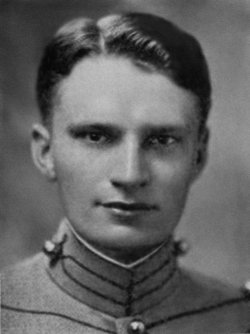 By this time Orin had also become quite proficient in polo and over the course of the ensuing years would travel intermittently to play and compete for the Army. He also continued his passion for running, a habit he formed while running cross-country at West Point and one that would heavily influence the training of his future 511th Parachute Infantry Regiment (much to the men's dismay).
By this time Orin had also become quite proficient in polo and over the course of the ensuing years would travel intermittently to play and compete for the Army. He also continued his passion for running, a habit he formed while running cross-country at West Point and one that would heavily influence the training of his future 511th Parachute Infantry Regiment (much to the men's dismay).
It was somewhere around this time that, ironically, the athletic Haugen started smoking cigarettes, a habit that was common at the time and would lead to several officers who served with Orin to label him a definitive "chain smoker." In fact, when fighting alongside the paratroopers of his 511th PIR in the mountains of Leyte in late 1944, Haugen was seen searching for cigarette butts to spear with a stick to get one final puff.
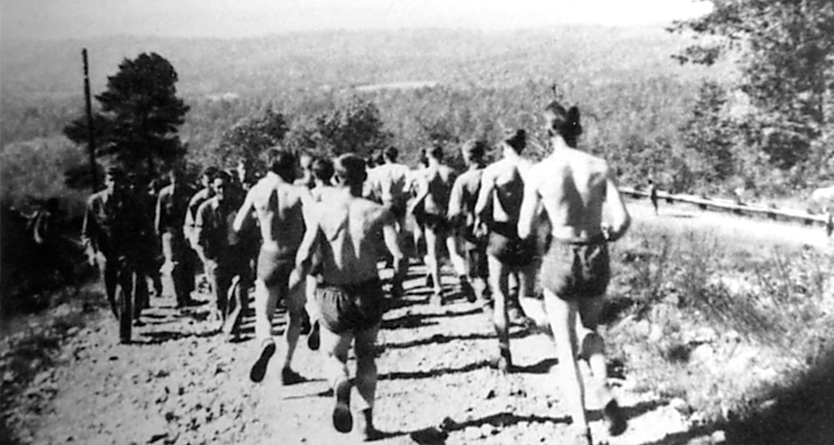
Camp Toccoa & the 511th PIR
 With America officially at war, in 1942 the country's military leadership began to accelerate the training of their still very new parachute troops. And Camp Toccoa, Georgia, now made famous by the HBO miniseries "Band of Brothers", played an important role in that effort.
With America officially at war, in 1942 the country's military leadership began to accelerate the training of their still very new parachute troops. And Camp Toccoa, Georgia, now made famous by the HBO miniseries "Band of Brothers", played an important role in that effort.
While Toccoa was, by comparison, a “little camp outside a little town far off the beaten path", over 18,000 young men and officers would train there and go on to fight overseas in northern AND southern France, in Holland, and at the Battle of the Bulge then "liberate" Hitler's Kehlsteinhaus, or Eagle's Nest, and then march down Pennsylvania Avenue after the war was over "over there".
At least, that is the limit to what most airborne enthusiasts and even some historians believe to be the case. Far too often the story of the 511th Parachute Infantry Regiment is overlooked or forgotten although it was the third of the four regiments (the 506th, 501st, 511th and 517th in that order) that formed at Camp Toccoa. Like all original Toccoa-men, the 511th cut its teeth (and "sweat blood") on the area's famous Currahee Mountain before, according to its future commander Colonel Edward H. Lahti, going on to create a "record unmatched in history".
But it is a record that most people know nothing about and it is of no surprise that my grandfather, 1st Lieutenant Andrew Carrico, III disliked most history books on the war since his beloved 511th PIR was hardly covered, if it was mentioned at all. His was a common sentiment among the "old troopers" of the 511th, and the 11th Airborne Division to which they belonged, a feeling of resentment they griped about at post-war regimental reunions for decades as attested to by my grandmother, Jane Carrico. Jane is a proud "Angelette" who became dear friends with many troopers and their wives and continues to champion the cause of the mighty 511th even after most of its men have made "the final jump."
With countless Hollywood movies, documentaries, television series, magazines articles, blog posts, podcasts and books dedicated to the 82nd (517th PIR), 101st (501st & 506th PIRs) and 17th Airborne Divisions (517th PIR), the question many 11th Airborne Division troopers painfully had for the remainder of their lives was: What about us?

When the Angels Sang on Leyte, Christmas of 1944
December 25, 1944
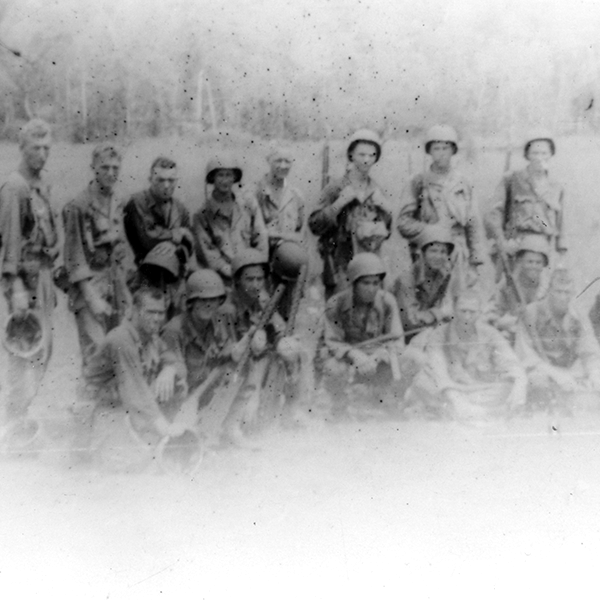 It was “a gray morning carved out of gray clay and shadowed by fog.”
It was “a gray morning carved out of gray clay and shadowed by fog.”
So penned T/4 Rodman "Rod" Serling of HQ1 a demolitions man who joined the several-miles-long column of bedraggled, trudging paratroopers coming down from Leyte’s hills. Rod and his comrades of the 511th Parachute Infantry Regiment had just completed 33 days of combat in those jungle-covered heights and mountains and as one of those troopers later declared, “After Leyte, Hell was a vacation.”
Hobbling on a wounded knee that would pain him for the rest of his life, Serling, the future creator of the famous television series “The Twilight Zone” did not feel like celebrating his twentieth birthday on “a God-forsaken mountaintop”. Rod noted, “(I)t was not the weather, it was the mood, I remember—the kind of mood that is the province of combat and is never fully understood by those who have not lived with the anguish of war.”
With Samurai swords and Japanese rifles jutting out of their packs, their last cigarettes safely tucked in cartridge belts, and hunching over from the weight of their equipment, the emaciated paratroopers, known as The Angels, trudged toward the beach with faces muted by the hells of war.
